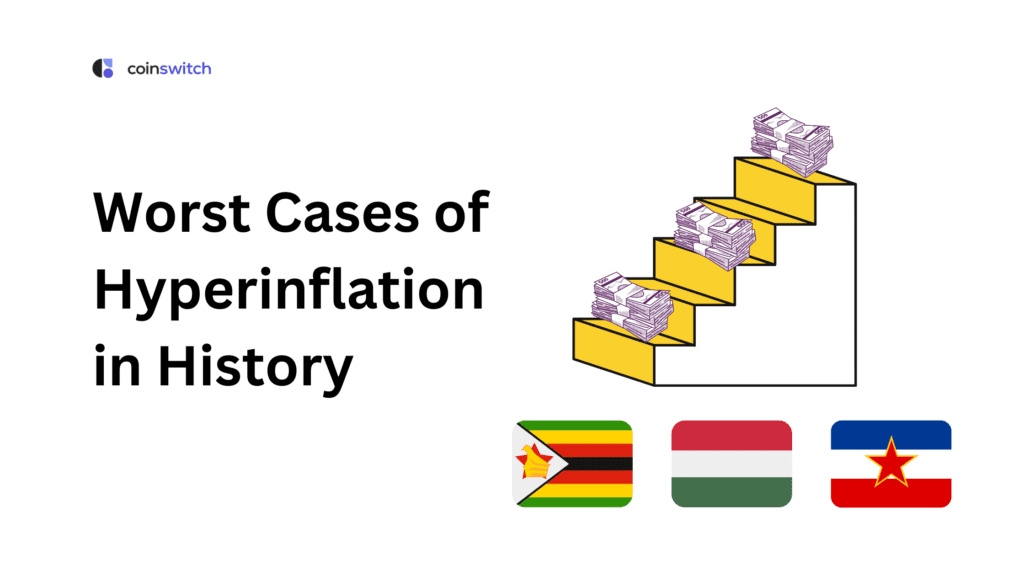Hyperinflation is the most severe form of monetary decline. It happens so quickly and out of control that regular ideas of value and price don’t make sense. Hyperinflation is an extreme form of inflation, when consumer prices typically rise over 50% per month.
However, there have been many examples of hyperinflation that exceed the standard 50% per month level. Over 50 countries have experienced hyperinflation at some point in history, leading to their economies collapsing, triggering widespread poverty and social unrest. Hyperinflation typically occurs when governments print excessive amounts of money to cover bills or fund expenditures. Prices rise daily as people lose faith in the currency. The problem gets worse as people rush to spend their money before it loses even more value.
Worst Cases of Hyperinflation in History
Some of the worst incidents of hyperinflation have been documented in Hungary, Zimbabwe, and Yugoslavia. Let’s learn about them in detail.
1. Hungary
People often attribute hyperinflation to a government that fails to perform its duties or mishandles finances. Hungary’s government caused hyperinflation after the war to fix the war-ravaged economy. The government taxed its people to help pay for war debts and payments to the Soviet army occupying the country.
Government Plans to Restore Industrial Capacity
World War II destroyed Hungary’s economy. It lost half of its industrial output, and its infrastructure was in shambles. This drop in Hungary’s ability to produce goods caused a supply shock, which, along with a fixed amount of money, led to the onset of hyperinflation.
Instead of trying to lower inflation by reducing the money supply and raising interest rates, which would have made an already weak economy even weaker, the government chose to inject new money through banks and into businesses. In some hyperinflation examples, similar tactics have caused currencies to plummet in value and the economy to deteriorate.
This aimed to restore the economy, infrastructure, and normalcy. The plan was effective, as Hungary had recovered much of its pre-war industrial capacity by the time the new currency, the forint, was introduced in August 1946, leading to stable prices once again.
2. Zimbabwe
Before it experienced hyperinflation in 2007, Zimbabwe’s economy was already in shambles. In 1998, the country’s yearly inflation rate reached 47%, which continued to rise until hyperinflation was triggered. As the Zimbabwean dollar’s value plummeted towards the conclusion of its hyperinflation phase, it was necessary to substitute it with several foreign currencies.
Government Abandons Fiscal Prudence
When Zimbabwe gained independence from the UK in 1980, its government initially implemented economic policies focused on careful budgeting. These policies emphasized prudent spending practices. But, as many hyperinflation examples show, moving away from this kind of control led to destructive economic chaos.
This promise didn’t hold. By the end of 1997, the economy was in trouble because the government was overspending. Politicians faced increasing problems, such as large protests against higher taxes and substantial payments to war heroes.
There was also opposition to the government’s plan to buy farms owned by white people and give them to the black majority of the country. Over time, the government’s finances deteriorated to the point where they could no longer be rectified. A problem with the money started to happen.
Many investors rushed to sell the country’s currency, causing the exchange rate to drop. This led to a surge in import prices, resulting in hyperinflation. The economy experienced cost-push inflation, when prices rise driven by increases in labor costs and raw materials.
Things worsened in 2000 after the government’s efforts to reform the land market had a negative impact on the economy. Poor implementation of the plan led to significant drop in farm production for several years. Low food production drove prices even higher.
Read More: Why inflation may not be as bad as you think: An explainer
Zimbabwe Enforces Tougher Monetary Regulations
The next thing the government did was to implement a strict monetary policy. Initially, the strategy was viewed as a success because it slowed down inflation; however, it had unintended consequences.
It disrupted the balance between the country’s supply and demand for goods, leading to demand-pull inflation—a phenomenon in which there is an insufficient supply to prevent prices from rising. In several hyperinflation examples, similar policy changes initially appeared to be effective but ultimately worsened the economy’s condition.
Zimbabwe’s central bank kept trying different things to fix the problems caused by its tight monetary policy. These measures were not very effective. By March 2007, the country was going through hyperinflation. Zimbabwe’s hyperinflationary situation began to improve when the government stopped using its own currency and started utilizing foreign money as a means of exchange.
3. Yugoslavia
After Yugoslavia broke up in early 1992 and the war began in Croatia and Bosnia-Herzegovina, monthly inflation in the new Federal Republic of Yugoslavia, formerly known as Serbia and Montenegro, reached 50%, a level associated with hyperinflation. Hyperinflation ensued after the first Yugoslav split, resulting from the dismantling of inter-regional commerce, which in turn led to productivity declines in several sectors.
Additionally, the enormous bureaucracy of the old Yugoslavia, which included a strong military and police force, remained largely unchanged in the new Federal Republic despite covering significantly less territory. As the war in Croatia and Bosnia-Herzegovina got worse, the government decided not to cut downsize the huge bureaucracy and its costs.
Government Inflates Money Supply
Between May 1992 and April 1993, the Federal Republic was prohibited from trading with other countries. This worsened the problem of falling output, similar to how the loss of factories in Hungary after World War II led to hyperinflation.
The government’s budget gap got worse as output and tax receipts fell. It went from 3% of GDP in 1990 to 28% of GDP in 1993. In many hyperinflation examples, the leading causes of the economy’s collapse were growing debts and falling revenues.
The government printed a large amount of money for circulation to compensate for this shortfall. The Topčider mint was producing approximately 900,000 bills every month by December 1993, but by the time they reached people’s bags, they were almost useless.
The currency dinar’s value dropped so quickly that the government couldn’t make enough money to keep up. On January 6, 1994, the currency finally fell apart. The German mark was designated as the new legal currency for all transactions, including tax payments.
Read More: What is inflation?
Hyperinflation FAQs
1. What is hyperinflation?
Hyperinflation occurs when prices for goods and services rise quickly and go out of control. Most agree that hyperinflation occurs when prices increase by 50% or more quickly. Throughout history, numerous examples of hyperinflation have demonstrated how rapidly prices can increase, ultimately destroying businesses and societies.
2. Are demand-pull inflation and hyperinflation the same thing?
Not at all. It is normal for prices to go up in a free market when too much money is trying to buy too few things. This is called demand-pull inflation. So, demand is higher than supply. It’s not too bad, and it gets better as manufacturers increase production to match demand.
3. What impact does hyperinflation have?
Hyperinflation causes widespread discontent and disrupts people’s lives. Food prices get out of hand, and there are shortages. People start stockpiling the things they need, which complicates the situation. People’s savings get depleted. Important decisions are put off. Families and companies can’t make ends meet for a while. A period of hyperinflation is characterized by a significant decline in living standards for most people.
The Bottom Line
When a country experiences hyperinflation, its business, government, and people suffer greatly. It often appears when problems are already underway, revealing what money is truly like. Money is more than just an economic tool used to buy things, store value, and keep track of accounts.
It is a sign of more profound social truths. The value and security of money depend on the stability of a country’s social and governmental systems. When these mechanisms fail, they contribute significantly to the devaluation of the currency in numerous hyperinflation examples.
FAQs
1. What is the most famous example of hyperinflation?
Hungary (1946), Zimbabwe (1997), and Yugoslavia (1992) are known examples of hyperinflation that people still recall. In Hungary, prices doubled daily; Zimbabwe introduced notes worth a trillion dollars; and Yugoslavia’s monthly inflation was the highest.
2. What has been the highest inflation rate in history?
Hungary now has the highest inflation rate ever documented. In July 1946, the monthly inflation rate hit 41.9 quadrillion percent, and prices doubled every 15 hours.
3. Who suffered from hyperinflation?
Hyperinflation has occurred in numerous places throughout history, including Hungary, Zimbabwe, and Yugoslavia. These are some examples of hyperinflation, and the common people suffered a lot in these situations. They ran out of basic goods, lost their funds, and the economy became unstable.
4. When was the worst time of inflation?
In July 1946, Hungary experienced the highest monthly inflation rate ever documented. As a result, this period is commonly regarded as having the highest inflation rate in recorded history.








